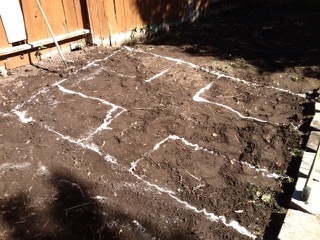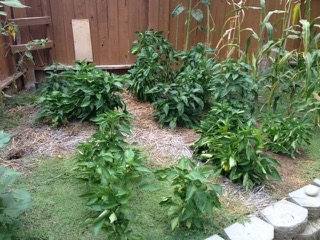Conducted by Master Gardener Volunteer, Lori Plakos.
I planted a 10'x10' test garden using different mulches to compare their effect on the production of bell peppers.


The test crop was bell peppers. Each plot was planted with three specimens each of red and yellow varieties which were purchased from a local nursery. These were planted on April 25, 2013. Unfortunately, the plants were subjected to a heat wave the following week, while I was out of town, and the housesitter had a difficult time keeping the plants moist, with the result that the control plot and the straw plot each lost a plant, and two died in the pine needle section, while those in the vermicompost all survived.
Variables to consider:
- Automatic sprinkler irrigation may have been inconsistent through the bed.
- Proximity to a fence may have influenced sun exposure. The straw and pine needle plants were furthest from the sun protection of the fence.
- Difficulty determining when to harvest. Waiting until peppers changed color appeared to be too late - they often rotted on the plant. I wasn't sure if I should consider all fruit, particularly toward end of season when fruit wasn't completely ripe. I included fruit of a particular size from all plants, even though I personally try to eat only colored peppers that are fully ripe. I know a lot of people eat green peppers.
Observations:
The non-mulched section (5 plants) grew weeds. The largest grasses were removed to prevent spread.
The straw mulch plants (5 plants) had problems with pests, mainly slugs. These were controlled using Sluggo 11. All of the plants had their share of pests, but the straw mulch was the worst. I've read that is a problem possibly due to the less dense nature of the straw harboring the pests. I have used a lot of straw mulch due to the fact it's readily available in my area and economical. I plan on running it through a shredder to make it more compactable and not using it where pests are a concern.
Those mulched with worm compost (6 plants) produced the strongest plants. The nutrients in the vermicompost helped the health of the plants. My preference would be to use that, but it is expensive to be able to use it over large areas. I do a lot of regular composting (mostly grass clippings and leaves), but I worry that working compost that isn't fully composted into the soil will compete with the plants. However, using it as a mulch will allow it to work in the soil over time when it is fully composted and giving the plants nutrients along the way.
The pine needle plants (4 plants) produced the largest crop per plant and overall in spite of the early plant losses and being furthest away from the fence's sun protection.
Results by Total Crop Weight rounding off to the nearest oz.
- Non-mulch: 52 oz.
- Straw mulch: 35 oz.
- Worm compost: 129 oz.
- Pine needles: 161 oz.
Conclusion:
The biggest thing I learned with this test is to MULCH. The most effective thing I learned about mulching during a drought is the resultant reduction in weeding and watering, which is very significant. The less attention you have to give to a particular plant, the more attention you can give to other parts of your garden.
The vermiculture mulch was the most expensive but those plants were the healthiest looking and best grown although they did not produce the heaviest crop. Those under pine needle mulch produced the best yield, far surpassing those grown either under straw or with no mulch at all.
